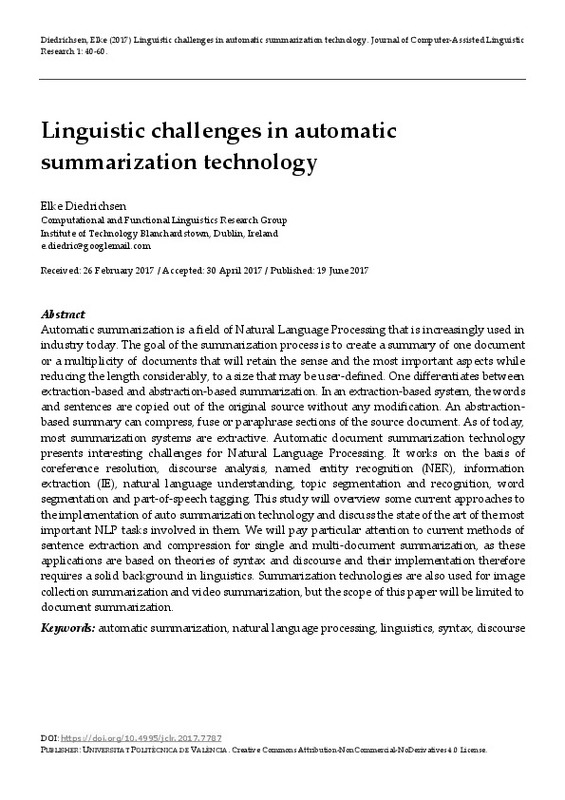JavaScript is disabled for your browser. Some features of this site may not work without it.
Buscar en RiuNet
Listar
Mi cuenta
Estadísticas
Ayuda RiuNet
Admin. UPV
Linguistic challenges in automatic summarization technology
Mostrar el registro sencillo del ítem
Ficheros en el ítem
| dc.contributor.author | Diedrichsen, Elke
|
es_ES |
| dc.date.accessioned | 2017-07-07T07:15:19Z | |
| dc.date.available | 2017-07-07T07:15:19Z | |
| dc.date.issued | 2017-06-26 | |
| dc.identifier.uri | http://hdl.handle.net/10251/84657 | |
| dc.description.abstract | [EN] Automatic summarization is a field of Natural Language Processing that is increasingly used in industry today. The goal of the summarization process is to create a summary of one document or a multiplicity of documents that will retain the sense and the most important aspects while reducing the length considerably, to a size that may be user-defined. One differentiates between extraction-based and abstraction-based summarization. In an extraction-based system, the words and sentences are copied out of the original source without any modification. An abstraction-based summary can compress, fuse or paraphrase sections of the source document. As of today, most summarization systems are extractive. Automatic document summarization technology presents interesting challenges for Natural Language Processing. It works on the basis of coreference resolution, discourse analysis, named entity recognition (NER), information extraction (IE), natural language understanding, topic segmentation and recognition, word segmentation and part-of-speech tagging. This study will overview some current approaches to the implementation of auto summarization technology and discuss the state of the art of the most important NLP tasks involved in them. We will pay particular attention to current methods of sentence extraction and compression for single and multi-document summarization, as these applications are based on theories of syntax and discourse and their implementation therefore requires a solid background in linguistics. Summarization technologies are also used for image collection summarization and video summarization, but the scope of this paper will be limited to document summarization. | es_ES |
| dc.language | Inglés | es_ES |
| dc.publisher | Universitat Politècnica de València | |
| dc.relation.ispartof | Journal of Computer-Assisted Linguistic Research | |
| dc.rights | Reconocimiento - No comercial - Sin obra derivada (by-nc-nd) | es_ES |
| dc.subject | Automatic summarization | es_ES |
| dc.subject | Natural language processing | es_ES |
| dc.subject | Llinguistics | es_ES |
| dc.subject | Syntax | es_ES |
| dc.subject | Discourse | es_ES |
| dc.title | Linguistic challenges in automatic summarization technology | es_ES |
| dc.type | Artículo | es_ES |
| dc.date.updated | 2017-07-07T07:00:34Z | |
| dc.identifier.doi | 10.4995/jclr.2017.7787 | |
| dc.rights.accessRights | Abierto | es_ES |
| dc.description.bibliographicCitation | Diedrichsen, E. (2017). Linguistic challenges in automatic summarization technology. Journal of Computer-Assisted Linguistic Research. 1(1):40-60. https://doi.org/10.4995/jclr.2017.7787 | es_ES |
| dc.description.accrualMethod | SWORD | es_ES |
| dc.relation.publisherversion | https://doi.org/10.4995/jclr.2017.7787 | es_ES |
| dc.description.upvformatpinicio | 40 | es_ES |
| dc.description.upvformatpfin | 60 | es_ES |
| dc.type.version | info:eu-repo/semantics/publishedVersion | es_ES |
| dc.description.volume | 1 | |
| dc.description.issue | 1 | |
| dc.identifier.eissn | 2530-9455 |








